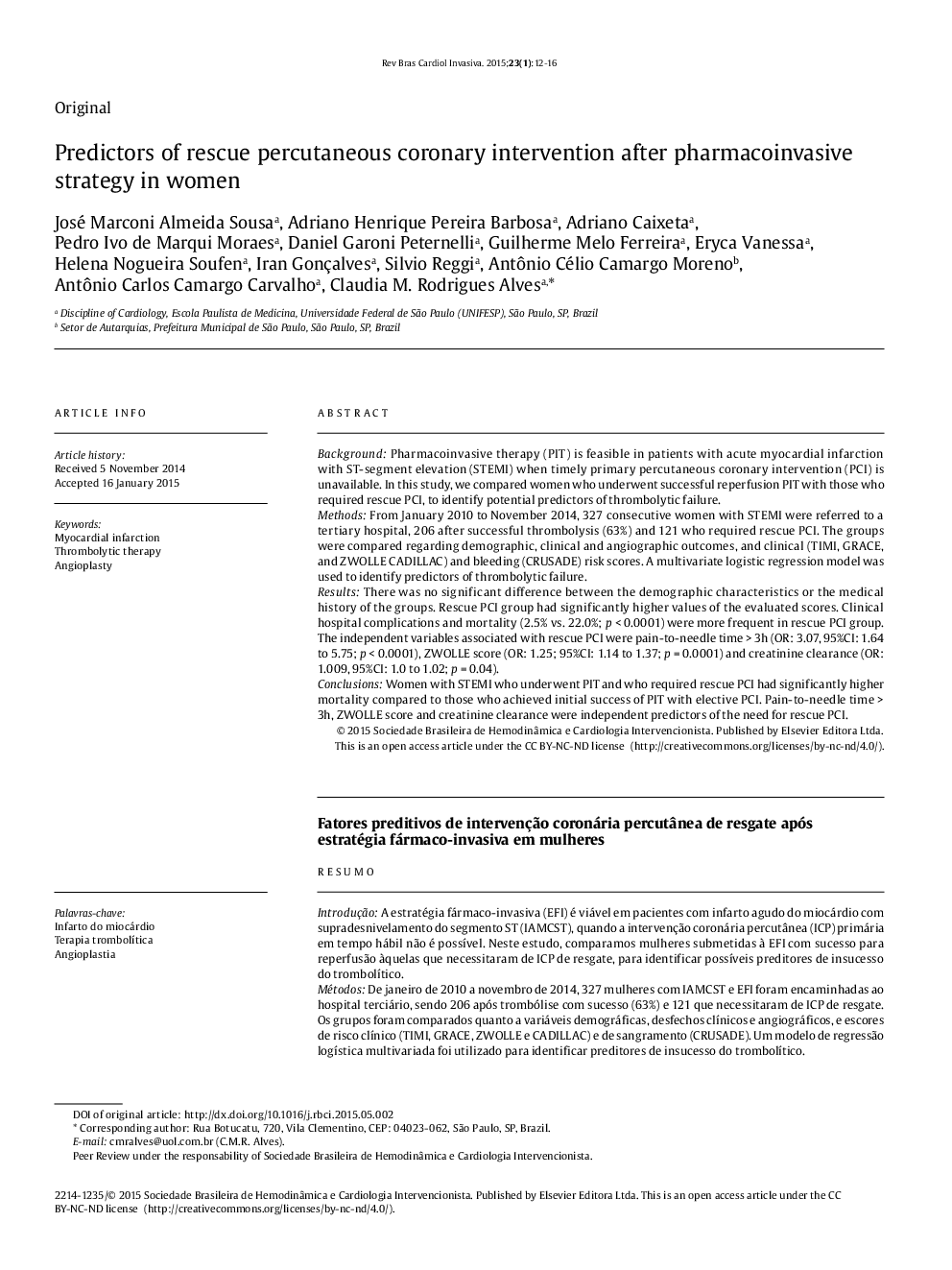| کد مقاله | کد نشریه | سال انتشار | مقاله انگلیسی | نسخه تمام متن |
|---|---|---|---|---|
| 3011809 | 1181772 | 2015 | 5 صفحه PDF | دانلود رایگان |
BackgroundPharmacoinvasive therapy (PIT) is feasible in patients with acute myocardial infarction with ST-segment elevation (STEMI) when timely primary percutaneous coronary intervention (PCI) is unavailable. In this study, we compared women who underwent successful reperfusion PIT with those who required rescue PCI, to identify potential predictors of thrombolytic failure.MethodsFrom January 2010 to November 2014, 327 consecutive women with STEMI were referred to a tertiary hospital, 206 after successful thrombolysis (63%) and 121 who required rescue PCI. The groups were compared regarding demographic, clinical and angiographic outcomes, and clinical (TIMI, GRACE, and ZWOLLE CADILLAC) and bleeding (CRUSADE) risk scores. A multivariate logistic regression model was used to identify predictors of thrombolytic failure.ResultsThere was no significant difference between the demographic characteristics or the medical history of the groups. Rescue PCI group had significantly higher values of the evaluated scores. Clinical hospital complications and mortality (2.5% vs. 22.0%; p < 0.0001) were more frequent in rescue PCI group. The independent variables associated with rescue PCI were pain-to-needle time > 3 h (OR: 3.07, 95%CI: 1.64 to 5.75; p < 0.0001), ZWOLLE score (OR: 1.25; 95%CI: 1.14 to 1.37; p = 0.0001) and creatinine clearance (OR: 1.009, 95%CI: 1.0 to 1.02; p = 0.04).ConclusionsWomen with STEMI who underwent PIT and who required rescue PCI had significantly higher mortality compared to those who achieved initial success of PIT with elective PCI. Pain-to-needle time > 3 h, ZWOLLE score and creatinine clearance were independent predictors of the need for rescue PCI.
ResumoIntroduçãoA estratégia fármaco-invasiva (EFI) é viável em pacientes com infarto agudo do miocárdio com supradesnivelamento do segmento ST (IAMCST), quando a intervenção coronária percutânea (ICP) primária em tempo hábil não é possível. Neste estudo, comparamos mulheres submetidas à EFI com sucesso para reperfusão àquelas que necessitaram de ICP de resgate, para identificar possíveis preditores de insucesso do trombolítico.MétodosDe janeiro de 2010 a novembro de 2014, 327 mulheres com IAMCST e EFI foram encaminhadas ao hospital terciário, sendo 206 após trombólise com sucesso (63%) e 121 que necessitaram de ICP de resgate. Os grupos foram comparados quanto a variáveis demográficas, desfechos clínicos e angiográficos, e escores de risco clínico (TIMI, GRACE, ZWOLLE e CADILLAC) e de sangramento (CRUSADE). Um modelo de regressão logística multivariada foi utilizado para identificar preditores de insucesso do trombolítico.ResultadosNão houve diferença significativa entre as características demográficas ou os antecedentes clínicos dos grupos. O grupo ICP de resgate apresentou valores significantemente maiores dos escores avaliados. Complicações clínicas hospitalares e mortalidade (2,5% vs. 22,0%; p < 0,0001) foram mais frequentes no grupo ICP de resgate. As variáveis independentes associadas à ICP de resgate foram tempo dor-agulha > 3 horas (OR 3,07; IC95% 1,64-5,75; p < 0,0001), escore ZWOLLE (OR 1,25; IC95% 1,14-1,37; p =0,0001) e clearance de creatinina (OR 1,009; IC95% 1,0-1,02; p = 0,04).ConclusõesMulheres com IAMCST submetidas à EFI e que necessitaram de ICP de resgate tiveram mortalidade significativamente maior quando comparadas àquelas que obtiveram sucesso inicial da EFI com ICP eletiva. Tempo dor-agulha > 3 horas, escore de ZWOLLE e clearance de creatinina foram preditores independentes da necessidade de ICP de resgate.
Journal: Revista Brasileira de Cardiologia Invasiva (English Edition) - Volume 23, Issue 1, July–August 2015, Pages 12–16
